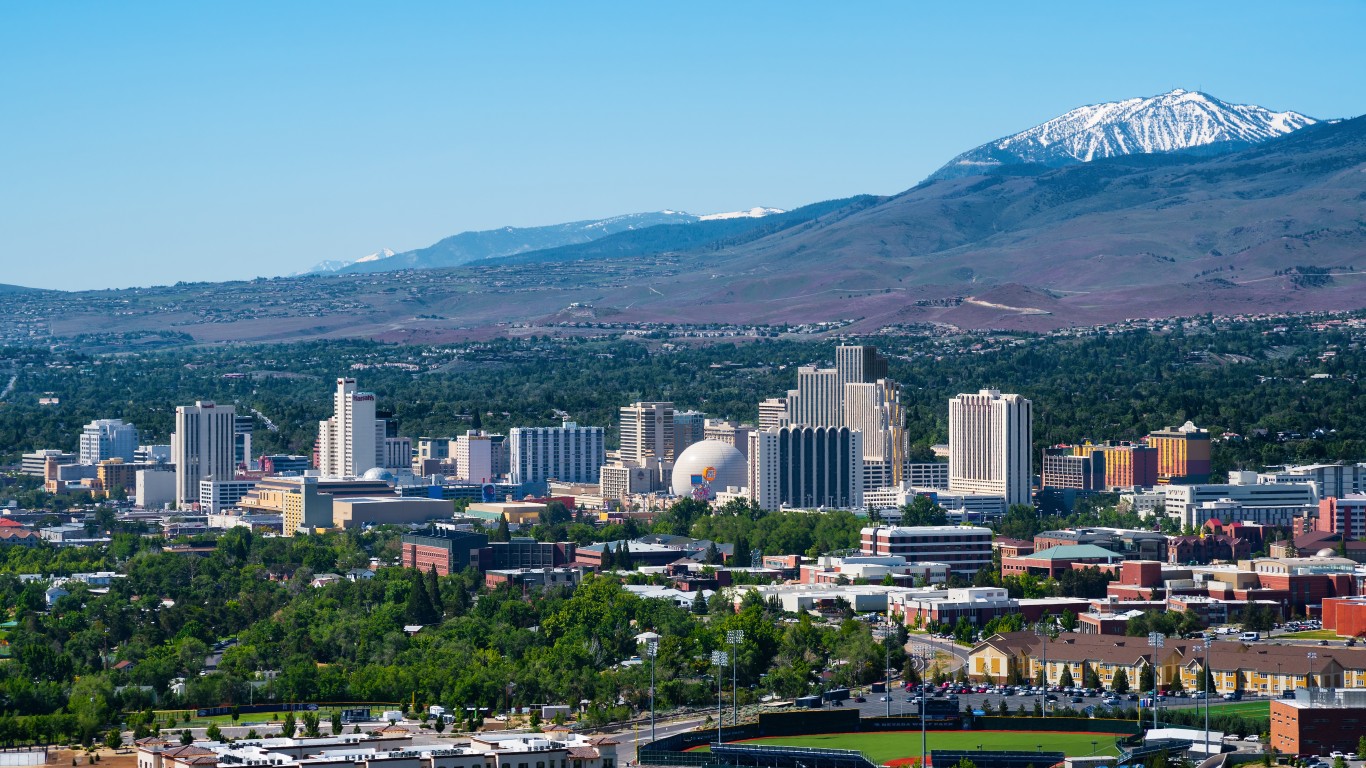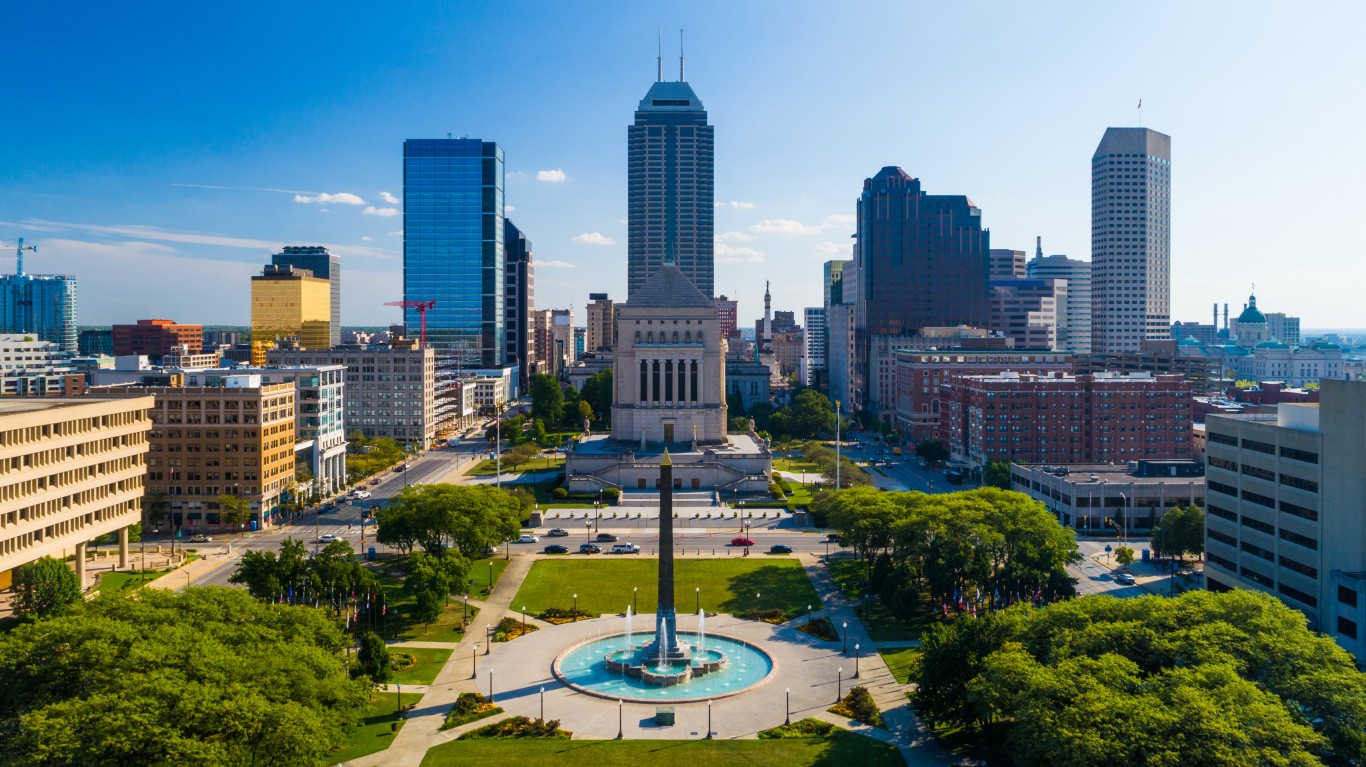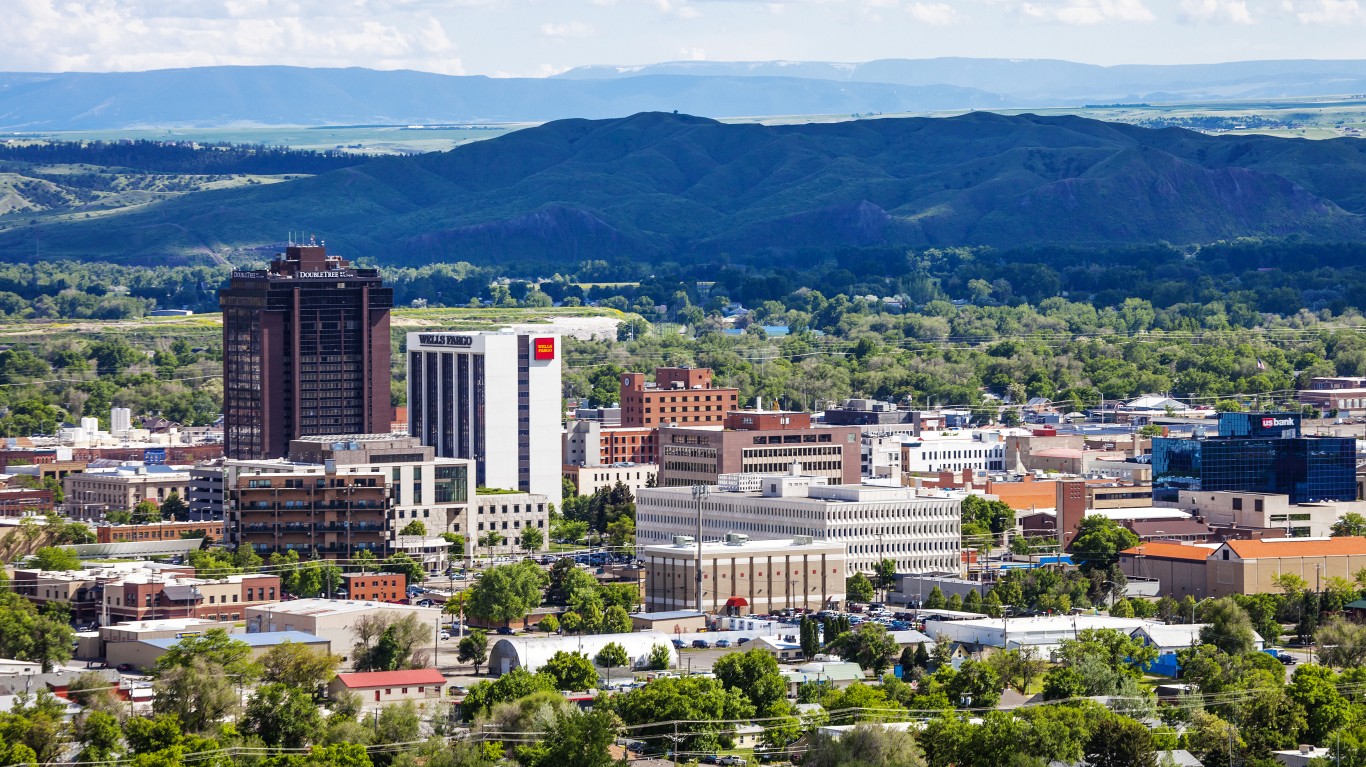
The consumer price index jumped by 0.8% in April — a far larger increase than many had anticipated. The recent spike in the cost of goods and services has led to widespread concerns over inflation. If the cost of living continues to climb at such a rapid pace, it will outpace wage growth, weakening the buying power of the American consumer. Such an outcome would be a reversal of the long-term trend in much of the United States.
Over the last 10 years, real personal income per capita, a measure of annual earnings that is adjusted for inflation, climbed by 25.5% in the United States — from $42,287 in 2010 to $53,071 in 2020. There are many potential factors that drove up real personal income, not the least of which is wage growth outpacing inflation.
While every state reported an increase in real personal income per capita, incomes in some states climbed far faster than in others. Using data from the Bureau of Economic Analysis, 24/7 Wall St. identified the 16 states where incomes are rising at a faster than average pace.
Other factors that can contribute to personal income growth include broad economic growth as well as longer average work days — meaning a single worker is producing more and often generating more income. Currently, the average American worker puts in about 34.5 hours per week, up from 34.1 hours in 2010. Here is a look at how long the typical work week is in other countries around the world.
For most of the states on this list, however, rapidly rising real income per capita appears to be largely the result of a growing share of the population working. In 12 of the 16 states on this list, workforce participation climbed at a faster than average rate between 2010 and 2020. One main reason for the growing workforce participation has been strong job growth in many of these states in the last decade. Here is a look at the American cities that added the most jobs during the pandemic.
Click here to see 16 states where income is rising the fastest.
To identify the states where incomes are booming, 24/7 Wall St. calculated the percentage growth in real personal income per capita from 2010 to 2020 with data from the Bureau of Economic Analysis. Data on personal income was adjusted from current dollars to constant 2012 dollars using the U.S. personal consumption expenditure price index and was adjusted for regional price differences using regional price parity in accordance with the methodology provided by the Bureau of Economic Analysis. Data on PCE and RPP, as well as supplemental data on GDP, also came from the BEA. Supplemental data on employment, employment by industry, and seasonally-adjusted unemployment came from the Bureau of Labor Statistics. Data on population and the components of population change from 2010 to 2020 came from the U.S. Census Bureau.

16. Ohio
> 10-yr. personal income per capita growth: +25.7%
> Personal income per capita: $52,849 (23rd highest)
> 10-yr. employment growth: +4.3% (25th lowest)
> 10-yr. real GDP growth: +13.6% (23rd highest)
Personal income per capita in Ohio climbed from $42,036 in 2010 to $52,849 in 2020. The 25.7% increase is slightly higher than the comparable increase nationwide and 16th highest among states. Ohio’s economy expanded by 13.6% over the same period, a faster pace than just over half of all states. GDP growth in the state was driven in large part by increased productivity, as Ohio’s workforce expanded by just 4.3% in the last 10 years, less than half the 9.1% increase in employment nationwide over that time.
While job creation in the Buckeye State over the last 10 years has been hampered by declines in several industries, including information and resource extraction — rapid growth in other industries, such as construction and professional and business services, helped offset those job losses.
[in-text-ad]

15. Nevada
> 10-yr. personal income per capita growth: +25.8%
> Personal income per capita: $48,896 (16th lowest)
> 10-yr. employment growth: +14.0% (11th highest)
> 10-yr. real GDP growth: +13.8% (22nd highest)
Income growth in Nevada has outpaced growth in much of the rest of the country since 2010. Real personal income per capita in the state stands at $48,896, up from $38,865 in 2010, a 25.8% increase.
Nevada was particularly hard hit during the Great Recession and was still struggling considerably in 2010 even as much of the U.S. was already beginning to recover from the recession. This partially explains Nevada’s rapid income growth from 2010 to 2020. Despite the faster than average growth, real personal income in Nevada is about $4,200 below the national average of $53,072.

14. Indiana
> 10-yr. personal income per capita growth: +26.4%
> Personal income per capita: $50,772 (24th highest)
> 10-yr. employment growth: +6.7% (18th highest)
> 10-yr. real GDP growth: +10.8% (22nd lowest)
Real personal income per capita in Indiana stands at $50,772, up over $10,000, or 26.4%, from 2010. One factor that can drive up personal income is the share of the population who are in the workforce. In Indiana, the share of the total population with a job increased from 43.2% to 44.2% between 2010 and 2020, a larger increase than in all but 13 other states.
Indiana’s job market improved considerably during the decade. The number of people working climbed by 6.7%, a larger increase than most other states reported. Additionally, the state’s annual jobless rate fell from 10.4% in 2010 to 7.1% in 2020.

13. Arizona
> 10-yr. personal income per capita growth: +26.8%
> Personal income per capita: $45,103 (4th lowest)
> 10-yr. employment growth: +19.4% (3rd highest)
> 10-yr. real GDP growth: +24.6% (9th highest)
Employment in Arizona surged by nearly 20% over the last decade. The near-nation leading increase was partially the result of the high unemployment rate the state recorded during the Great Recession. The recession left Arizona’s economy in far worse condition than most in 2010, with 10.4% of the state’s labor force unemployed. Arizona’s annual unemployment rate stood at 7.9% as of 2020.
As Arizona added jobs, the share of the population in the workforce climbed from 37.3% to 38.4%, one of the larger increases among states. The uptick in workforce participation partially explains the rapid personal income per capita growth in Arizona. Personal income per capita climbed from $35,573 in 2010 to $45,103 in 2020, a 26.8% growth.
[in-text-ad-2]

12. Montana
> 10-yr. personal income per capita growth: +27.1%
> Personal income per capita: $50,465 (22nd lowest)
> 10-yr. employment growth: +9.7% (15th highest)
> 10-yr. real GDP growth: +14.5% (21st highest)
Real personal income per capita stands at $50,465 in Montana, up 27.1% from 2010. Real income rises when wage growth outpaces inflation, and wages in Montana have surged in the last decade. Weekly earnings in the state averaged $846 in 2020, a 28.6% increase from 2010, when the average private sector worker earned $658 a week.
Job growth has also been strong in Montana. Overall employment rose 9.7% from 2010 to 2020, one of the larger improvements among states. Over the same period, the state’s annual unemployment rate fell from 7.3% to 5.9%.

11. Pennsylvania
> 10-yr. personal income per capita growth: +27.9%
> Personal income per capita: $56,923 (7th highest)
> 10-yr. employment growth: -0.3% (10th lowest)
> 10-yr. real GDP growth: +11.6% (25th highest)
Pennsylvania reported stronger inflation-adjusted per capita income growth than all but 10 other states over the last decade. Real personal income per capita in the Keystone state stands at $56,923, 27.9% higher than it was in 2010.
Real income can rise when wages climb faster than overall inflation, and when workers put in longer hours on the job — and both factors appear to have been driving income growth in Pennsylvania. Private sector workers put in an average of 34.3 hours a week in 2020 in Pennsylvania, up from 33.3 in 2010, the third largest increase among states. Over the same period, the average weekly wage in the state climbed from $707 to $936, a larger increase than in all but 10 other states.
[in-text-ad]

10. Washington
> 10-yr. personal income per capita growth: +28.8%
> Personal income per capita: $55,607 (13th highest)
> 10-yr. employment growth: +15.8% (7th highest)
> 10-yr. real GDP growth: +42.8% (the highest)
Real personal income per capita in Washington rose 28.8% over the last decade, from $43,173 in 2010 to $55,607 in 2020. Over the same period, Washington has undergone rapid economic growth. The state’s GDP expanded by 42.8%, the most of any state and more than double the 18.1% national economic growth over that time.
In addition to strong economic growth, an uptick in working hours has also likely contributed to the surge in real personal income per capita in Washington. The typical worker in the state puts in 34.9 hours per week, up from 34.1 hours in 2010 — one of the largest increases of any state.

9. Oregon
> 10-yr. personal income per capita growth: +29.0%
> Personal income per capita: $49,328 (17th lowest)
> 10-yr. employment growth: +13.7% (12th highest)
> 10-yr. real GDP growth: +29.6% (7th highest)
Real personal income per capita in Oregon stands at $49,328, up 29.0% from a decade ago. Wages rising faster than the cost of living likely contributed to the surge in real per capita income in the state. The average weekly wage in Oregon is $975, up 34.7% from $724 in 2010. Nationwide, average weekly wages rose by 31.8% over the same period.
Oregon also has a larger share of the population in the workforce compared to a decade ago, and this has also likely driven up real personal income per capita in the state. Overall employment climbed by 13.7% between 2010 and 2020, outpacing the state’s 10.7% population growth over the same period. An estimated 43.0% of Oregon’s population were working as of 2020, up from 41.9% in 2010.

8. Arkansas
> 10-yr. personal income per capita growth: +29.1%
> Personal income per capita: $48,263 (12th lowest)
> 10-yr. employment growth: +6.8% (17th highest)
> 10-yr. real GDP growth: +8.7% (17th lowest)
Real personal income per capita in Arkansas was 29.1% higher in 2020 than it was a decade ago — well above the comparable growth nationwide. Despite the increase, real personal income is still relatively low in Arkansas, at $48,263 per capita compared to $53,072 nationwide.
The increase in Arkansas appears to be largely attributable to greater work force participation. Just 39.9% of the state’s population worked in 2010, compared to 41.0% in 2020. The increase is the 12th highest of any state.
[in-text-ad-2]

7. New York
> 10-yr. personal income per capita growth: +29.7%
> Personal income per capita: $56,186 (9th highest)
> 10-yr. employment growth: +2.7% (19th lowest)
> 10-yr. real GDP growth: +10.6% (20th lowest)
In 2010, real personal income per capita was $43,313 in New York state, the 20th highest among the 50 states. As of 2020, real personal income in the state was $56,186 — ninth highest among states. The 29.7% 10-year increase in inflation-adjusted income per capita is the one of the highest in the country.
As is often the case, the increase in income per capita in New York appears to be largely attributable to increased workforce participation, from 44.1% of the population working in 2010 to 45.4% in 2020. Employment in the state grew by 2.7% over the last decade, even as the state’s population contracted by 4.4%.

6. Michigan
> 10-yr. personal income per capita growth: +30.5%
> Personal income per capita: $50,706 (25th lowest)
> 10-yr. employment growth: +4.3% (23rd lowest)
> 10-yr. real GDP growth: +11.3% (24th lowest)
Michigan is one of only six states where real personal income per capita increased by more than 30% in the last decade. Inflation-adjusted income per capita in the state stands at $50,706, up from $38,867 in 2010.
Longer working days and greater workforce participation likely explain the climbing income. Workers in the state put in an average of 34.2 hours per week, up 1.5% from 2010 — one of the 10 largest increases among states. Additionally, 40.5% of the state’s population worked in 2020, compared to just 39.1% in 2010. The increase is the seventh highest of any state.
[in-text-ad]

5. Idaho
> 10-yr. personal income per capita growth: +31.2%
> Personal income per capita: $46,567 (8th lowest)
> 10-yr. employment growth: +25.2% (2nd highest)
> 10-yr. real GDP growth: +27.8% (8th highest)
Inflation-adjusted per capita income in Idaho stands at $46,567 — among the 10 lowest of any state. Still, it is 31.2% higher than it was a decade ago, the fifth largest increase among states.
The increase in Idaho was likely driven by rapidly climbing workforce participation. An estimated 41.3% of the state’s population are employed, up from just 38.5% in 2010 — the second largest increase of any state. Greater workforce participation came, in part, through rapid job creation, as employment climbed by over 25% in the last decade, more than double the 9.1% national job growth over that time. Construction and education and health services were the fastest growing industries by employment in Idaho between 2010 and 2020.

4. Colorado
> 10-yr. personal income per capita growth: +31.7%
> Personal income per capita: $55,369 (14th highest)
> 10-yr. employment growth: +19.1% (4th highest)
> 10-yr. real GDP growth: +32.3% (5th highest)
Real personal income per capita climbed by 31.7% in Colorado over the last decade — from $42,054 in 2010 to $55,369 in 2020. The increase came over a period of rapid economic growth in the state. Colorado’s inflation-adjusted GDP surged by 32.3% between 2010 and 2020, compared to 18.1% nationwide over the same period.
As is often the case in states where personal incomes have surged in recent years, Colorado has greater workforce participation than it did a decade ago. As of 2020, 45.5% of the state’s population were employed, compared to 44.2% in 2010 — the sixth largest such increase among states.

3. Illinois
> 10-yr. personal income per capita growth: +32.0%
> Personal income per capita: $57,412 (5th highest)
> 10-yr. employment growth: +1.4% (13th lowest)
> 10-yr. real GDP growth: +7.0% (16th lowest)
Income per capita, adjusted for inflation, stands at $57,412 in Illinois — 32% higher than in 2010, when real personal income per capita in the state was just $43,506. Over the same period, average weekly wages in the state, not adjusted for inflation, climbed 30.1% — from $796 to $1,036.
The surge in personal income in Illinois was likely driven primarily by greater workforce participation. Since 2010, the state’s population contracted by 5.7%, while overall employment climbed by 1.4% over the same period. Professional and business services and construction were the two fastest growing industries by employment in Illinois between 2010 and 2020.
[in-text-ad-2]

2. California
> 10-yr. personal income per capita growth: +35.0%
> Personal income per capita: $53,097 (22nd highest)
> 10-yr. employment growth: +13.0% (14th highest)
> 10-yr. real GDP growth: +32.4% (4th highest)
Real personal income per capita was just $39,321 in California in 2010 — 15th lowest of any state. As of 2020, real personal income per capita was $53,097 in the state, 22nd highest among the 50 states. The 35% 10-year increase is the second highest of any state.
A confluence of factors in California contributed to the near-nation leading real income growth. Over the last 10 years, GDP growth, work force participation growth, and average weekly earnings growth were each among the five highest of any state. Any one of these factors alone could contribute to strong growth in real personal income per capita.

1. Utah
> 10-yr. personal income per capita growth: +39.0%
> Personal income per capita: $48,052 (10th lowest)
> 10-yr. employment growth: +29.6% (the highest)
> 10-yr. real GDP growth: +36.6% (3rd highest)
Real personal income per capita climbed by 39.0% in Utah over the last decade — from $34,576 in 2010 to $48,052 in 2020 — by far the largest percentage increase in the country. Increased workforce participation likely explains the surge in per capita income, as 47.1% of Utah’s population are employed, up from 42.8% in 2010 — the largest increase of any state.
Greater labor participation came along with the strongest job growth in the country. Between 2010 and 2020, employment climbed by nearly 30% in Utah, triple the comparable 9.1% U.S. job growth. Over the same period, unemployment in Utah fell from 7.8% to 4.7%. Professional and business services and construction were the two fastest growing industries by employment in Utah between 2010 and 2020.
The Average American Is Losing Their Savings Every Day (Sponsor)
If you’re like many Americans and keep your money ‘safe’ in a checking or savings account, think again. The average yield on a savings account is a paltry .4% today, and inflation is much higher. Checking accounts are even worse.
Every day you don’t move to a high-yield savings account that beats inflation, you lose more and more value.
But there is good news. To win qualified customers, some accounts are paying 9-10x this national average. That’s an incredible way to keep your money safe, and get paid at the same time. Our top pick for high yield savings accounts includes other one time cash bonuses, and is FDIC insured.
Click here to see how much more you could be earning on your savings today. It takes just a few minutes and your money could be working for you.
Thank you for reading! Have some feedback for us?
Contact the 24/7 Wall St. editorial team.
 24/7 Wall St.
24/7 Wall St.
